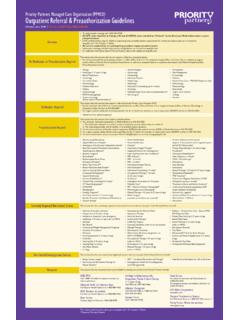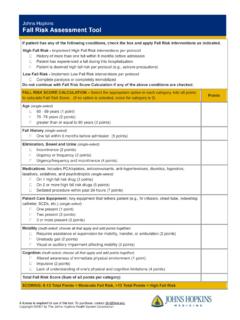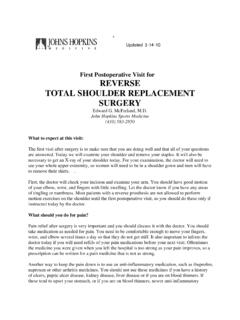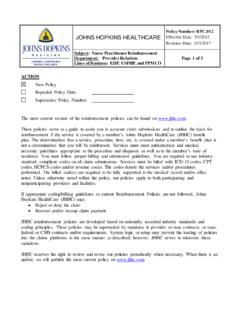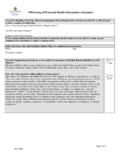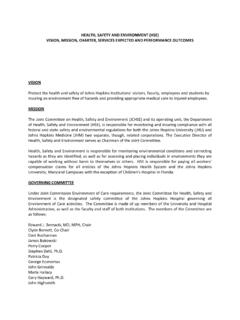Transcription of Portal Hypertension: Introduction - Hopkins Medicine
1 Figure 1. Location of liver in the Hypertension: Introduction As early as the 17th century, it was realized that structural changes in the Portal circulation could cause gastrointestinal 1902, Gilbert and Carnot introduced the term " Portal hypertension" to describe this condition. Portal hypertension is a pressurein the Portal venous system that is at least 5 mm Hg higher than the pressure in the inferior vena cava. This increased pressureresults from a functional obstruction to blood flow from any point in the Portal system's origin (in the splanchnic bed) through thehepatic veins (exit into the systemic circulation) or from an increase in blood flow in the progress has been made in understanding the pathophysiology of Portal hypertension.
2 This knowledge has led to thedevelopment of new therapeutic management approaches such as pharmacological therapies, endoscopic therapies, andsurgical and radiological shunting procedures. Although many advances have been made in this field, the complications of portalhypertension (gastrointestinal hemorrhage, hepatic encephalopathy, hepatorenal syndrome, and ascites) continue to be the causeof significant morbidity and mortality. Portal hypertension remains one of the most serious sequelae of chronic liver disease.
3 What is Portal Hypertension? Portal hypertension is a term used to describe elevated pressures in the Portal venous system (a major vein that leads to the liver). Portal hypertension may becaused by intrinsic liver disease, obstruction, or structural changes that result in increased Portal venous flow or increased hepatic resistance. Normally, vascularchannels are smooth, but liver cirrhosis can cause them to become irregular and tortuous with accompanying increased resistance to flow. This resistance causesincreased pressure, resulting in varices or dilations of the veins and tributaries.
4 Pressure within the Portal system is dependent upon both input from blood flow in theportal vein, and hepatic resistance to outflow. Normally, Portal vein pressure ranges between 1 4 mm Hg higher than the hepatic vein free pressure, and not morethan 6 mm Hg higher than right atrial pressure. Pressures that exceed these limits define Portal hypertension. SymptomsGastrointestinal hemorrhage may be the initial presenting symptom of patients with Portal hypertension. Those patients with more advanced liver disease oftenpresent with ascites, hepatic encephalopathy , jaundice, coagulopathy, or spider angiomata.
5 Patients who are hemodynamically stable may have warm skin,hyperdynamic pulses, and low systolic blood pressures in the range of 100 110 mm Hg. Additionally, splenomegaly and dilated abdominal wall veins are alsoindicative of Portal hypertension. Splenomegaly can result in sequestration of platelets from the systemic circulation, and low platelet counts may be the earliestabnormal laboratory finding. Hepatomegaly is variable and dependent upon the cause and stage of liver disease. Portal vein thrombosis may occur as a complicationof Portal hypertension but may also occur in cases of myeloproliferative or hypercoagulable clinical manifestations of Portal hypertension may include caput medusae, splenomegaly, edema of the legs, and gynecomastia (less commonly) (Figure 2).
6 Figure 2. Clinical manifestations of Portal hypertensionCaput medusae is a network of dilated veins surrounding the umbilicus. It is caused by increased blood flow in the umbilical and periumbilical veins and is oftenaccompanied by an audible venous hum over the umbilical vein (Cruveilhier-Baumgarten murmur). Gynecomastia refers to the unilateral or bilateral abnormalenlargement of breast tissue behind the areola in males. It may be precipated by hormonal imbalance or hormone-secreting tumors, testicular or pituitary tumors, liverfailure, and antihypertensive medications or medications containing estrogen or steroids.
7 Edema, or swelling of the legs, is seen in Portal hypertensive patientsbecause of alterations in systemic hemodynamics. Portal Hypertension: Anatomy The liver is located in the right upper quadrant, from the fifth intercostal space in the midclavicular line down to the right costal margin. The liver weighs approximately1800 g in men and 1400 g in women. The surfaces of the liver are smooth and convex in the superior, anterior, and right lateral regions. Indentations from the colon,right kidney, duodenum , and stomach are apparent on the posterior line between the vena cava and gallbladder divides the liver into right and left lobes.
8 Each lobe has an independent vascular and duct supply. The liver is furtherdivided into eight segments, each containing a pedicle of Portal vessels, ducts, and hepatic Portal venous system extends from the intestinal capillaries to the hepatic sinusoids (Figure 3). This venous system carries the blood from the abdominalgastrointestinal tract, the pancreas, gallbladder, and spleen back to the heart (coursing through the liver). The largest vessel in this system is the Portal vein, which isformed by the union of the splenic vein and superior mesenteric veins.
9 The left gastric and right gastric veins and the posterior superior pancreaticoduodenal veindrain directly into the Portal vein. The Portal vein runs posterior to the pancreas, and its extrahepatic length may be anywhere from 5 9 cm. At the porta hepatis, itdivides into the right and left Portal veins within the liver, and the cystic vein typically drains into the right hepatic branch. Figure 3. Anatomy of the Portal venous Portal vein supplies 70% of the blood flow to the liver, but only 40% of the liver oxygen supply.
10 The remainder of the blood comes from the hepatic artery, andblood from both of these vessels mixes in the liver receives a tremendous volume of blood, on the order of liters per minute. The dual blood supply allows the liver to remain relatively resistant tohypoxemia. Unlike the systemic vasculature, the hepatic vascular system is less influenced by vasodilation and vasoconstriction. This is because the sinusoidalpressures remain relatively constant despite changes in blood flow. A classic example is hepatic vein occlusion resulting in high sinusoidal pressure and extracellularextravasation of fluid.



